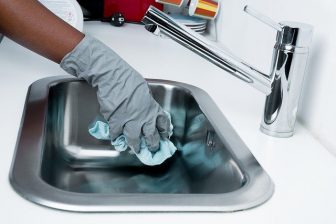 For this month’s case we are going to take a look at a claim for cleaning with a bit of a twist.
For this month’s case we are going to take a look at a claim for cleaning with a bit of a twist.
Whilst at first glance this seemed to be a standard end of tenancy cleaning claim, the tenant presented an interesting case by stating that their own cleaning works were cut short by the early arrival of the landlord before the designated check-out time.
They also highlighted that as the invoice provided by the landlord was dated a few weeks after the tenancy had ended, which was after the date redecoration works were undertaken, which formed part of the claim against the deposit, they had concluded they were being charged for the cleaning works required after the property had been redecorated in full.
Further to this reasoning, the tenant also claimed that various cleaning issues were present when they moved into the property and had provided some images showing some cobwebs in the ceiling corners, in addition to cigarette butts on the property balcony.
The evidence
Whilst at a first glance the arrival of the landlord at the property a few hours before the check-out time may have seemed like a contributing factor to consider, no evidence had been provided to show that this actually prevented the tenant from carrying out their contractual obligation to return the property to the same standard of cleanliness. The adjudicator was therefore unable to accept this as a valid reason for the property not to have been left in clean condition.
Adjudicators quite often come across cases where the provided invoice or quotation is dated after the tenancy had ended, being the date, the invoice was produced. Whilst it was reasonable for the tenant to have highlighted this, especially as other works were being carried out in the property, this does not usually impact the outcome of the decision. This is because whilst an invoice is useful for establishing if the amount claimed is reasonable or not, the decision is based upon the findings of the check-out report which records the cleanliness of the property at the end of the tenancy and is therefore the adjudicator’s key point of reference when ascertaining the cleaning works which the tenant is responsible for.
The result
The adjudicator was therefore able to make an award for the majority of the amount being claimed by the landlord and made a small deduction to account for the cobwebs and cigarette butts the tenant had been able to show as being present at the start of the tenancy. An interesting point to note here is that the tenant in their submission had actually listed several more cleaning issues they claimed to have been present at the start of the tenancy but had not provided any additional evidence to support their statement, in relation to these further cleaning issues from the start of the tenancy.
The importance of using a deposit protection scheme
Using a deposit protection scheme, like the Tenancy Deposit Scheme, provides both landlords and tenants with a secure way to handle deposit disputes. The adjudicators rely on clear, unbiased evidence to make decisions, ensuring that all parties are treated fairly under the guidelines of a deposit protection scheme.
So, what are the key points here?
+ Invoices and quotations are useful documents to include as they often show the exact cost of works being claimed and may include a breakdown detailing how much each area of repair or cleaning cost. If these are dated a few weeks after the tenancy had ended, they would not be disregarded however if they contained a report or statement in relation to liability, for example confirming the cause of a leak or blockage, the date would hold a lot more significance and would need to be considerably closer to the end of the tenancy.
+ Check-out reports must be as close to the end of the tenancy as possible so that they may be relied upon as an accurate record of the property condition and cleanliness at the end of the tenancy. Had this key document been dated a few weeks after the tenancy had ended, the tenant’s reasoning in relation to being charged for additional works would have held more weight.
+ As a tenant, it is important to have supporting evidence in relation to all the issues which are claimed to have been present at the start of the tenancy. This can be in the form of dated photographs, or correspondence copies showing that they were reported to the landlord or agent at the time.
+ If a tenant is claiming that a particular event or circumstance prevented them from carrying out their contractual obligations, evidence needs to be shown to that effect. If it had been the check-out clerk who had arrived a few hours early and it was clear from the issued report that the tenant had been in the process of cleaning, the outcome would have been different.
If you are interested in further guidance relating to TDS deposit protection scheme advice on disputes, visit our Help Centre to browse further guides.
If you are interested in further guidance relating to deposit disputes, visit the Help Centre at TDS to browse further guides.
Sandy Bastin, is head of adjudication services at Tenancy Deposit Scheme (TDS), the only not-for-profit tenancy deposit protection scheme.


Comments are closed.